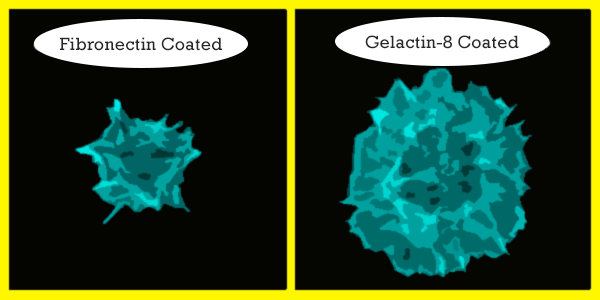Differential cellular responses to adhesive interactions with galectin-8- and fibronectin-coated substrates
- By Cytoskeleton Inc. - ECM News
- May 16, 2022

The extracellular matrix (ECM) is a structural network consisting of extracellular macromolecules, such as collagen, fibronectin, glycoproteins and laminin that provide support to surrounding cells through facilitating cell adhesion, cell differentiation, and cell-to-cell communication. Many studies have investigated the regulatory mechanisms activated by ECM proteins but, but there is still much to learn. A recent study by Li. et al. systematically investigated fibronectin and galectin-8 effects on cellular responses either alone or in combination. Detailed timecourse studies of Hela cells grown on fibronectin or galectin-8 coated substrates revealed distinctly different cell spreading patterns. Specifically, galectin-8 coating produced pronounced lamellipodia formation without pause, whereas fibronectin lamellipodia occurred more erratically. These differences observed in the filopodia and lamellipodia produced on these two ECM substrates were attributed to changes in the actomyosin cytoskeletal organization. These differences can be partially reversed by manipulation of small G-proteins of the Rho family and their downstream targets. When cells were grown on a combination of fibronectin and galectin-8, the precise ratio of the two ECM dictated cell spreading, focal adhesion, and filopodia; for some morphological changes, the combination was antagonistic while in the case of filopodia the combination was synergistic.
Cytoskeleton’s fluorescently labeled fibronectin (Cat. # FNR02) was an essential tool used to investigate how different ECM substrates regulate cell morphology.

Schematic Cell spreading on substrates comprised of Fibronectin vs Galectin-8.
Link to Citation:
Related Products/Products Used
Fibronectin (Green Fluorescent, HiLyte 488) (Cat. # FNR02)
